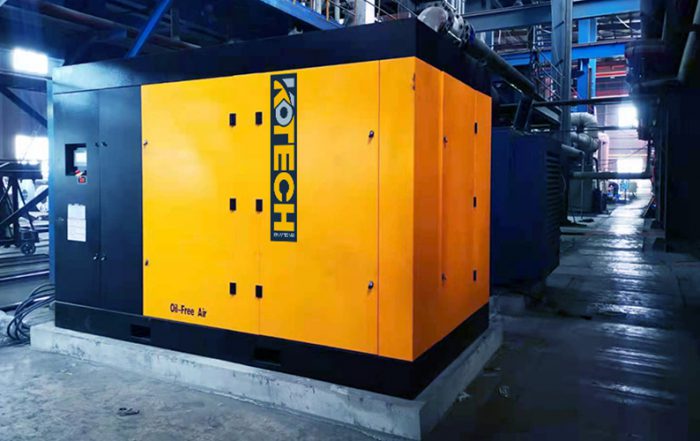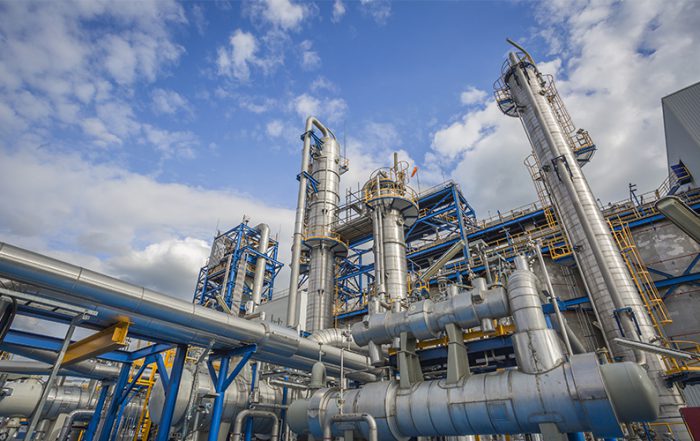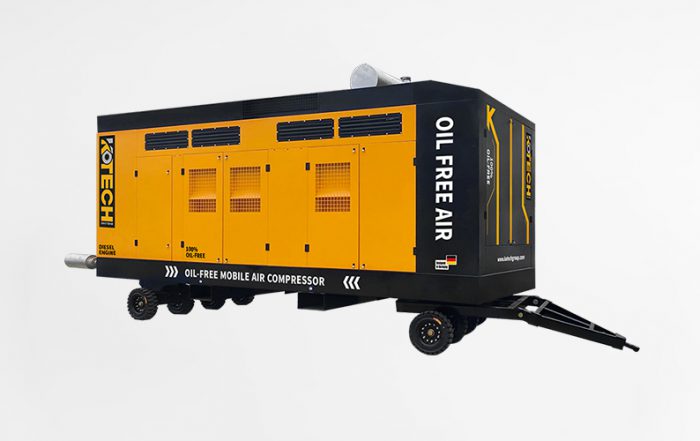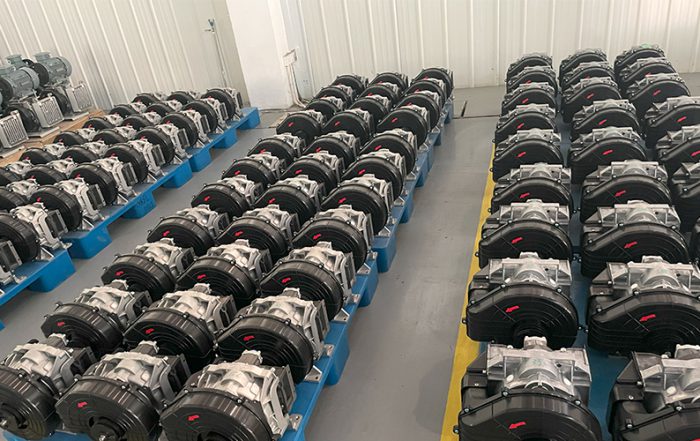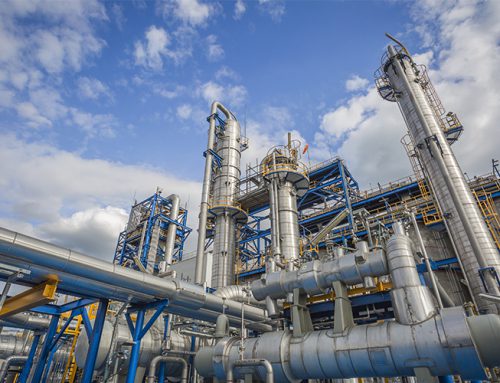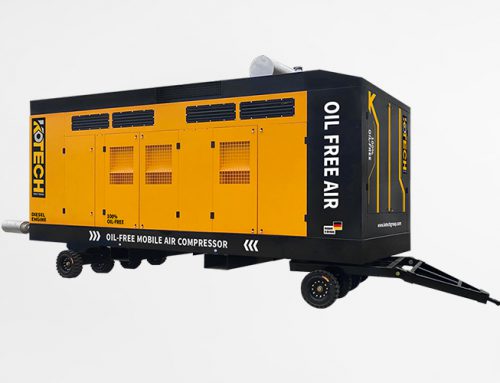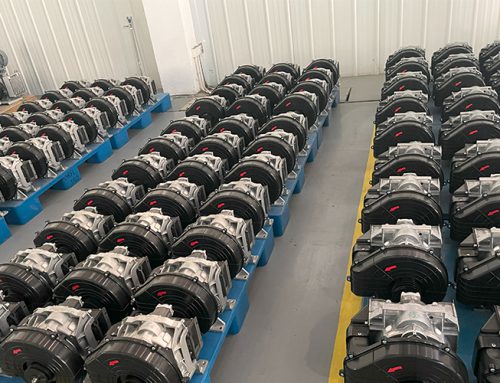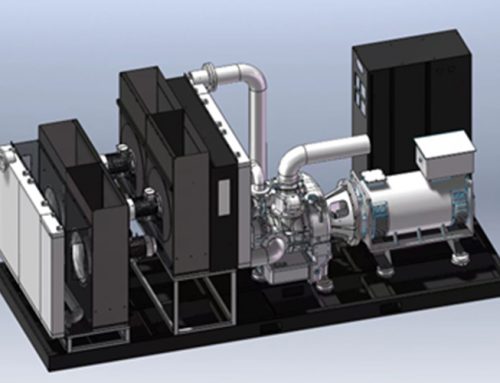What is the difference between oil and oil-free screw air compressors?
1. Introduction
1.1. Overview of Air Compressors
An air compressor, or air compressor, is a primary component of a gas source system. It converts the mechanical energy of a prime mover (usually an electric motor) into gas pressure energy, functioning as a device that generates compressed air. This essential machinery compresses air into high-pressure gas, providing multiple functionalities such as power supply, pipeline transportation, and environmental protection. Air compressors are widely used across various fields:
- Power Systems: Compressed air serves as a power source for machinery, pneumatic tools, control instruments, and automatic devices. Common applications include:
- Traditional pneumatic tools such as rock drills, jackhammers, pneumatic wrenches, and pneumatic sandblasting tools, with pressures typically ranging from 0.6 to 1.5 MPa.
- Instrument control and automation devices like tool changers in machining centers, with pressures around 0.6 MPa.
- Vehicle braking systems and window/door operation mechanisms with pressures generally between 0.2 and 0.6 MPa.
- Air-jet looms that use compressed air to propel the weft, replacing the shuttle, with pressures between 0.1 and 0.2 MPa.
- Food and pharmaceutical industries for stirring liquids with compressed air, with pressures typically from 0.2 to 0.6 MPa.
- Starting large marine diesel engines with pressures ranging from 2.5 to 6.0 MPa.
- Wind tunnel experiments, ventilation in underground passages, and metal smelting, with pressures between 6.0 and 10 MPa.
- Oil well fracturing with a pressure of 15 MPa.
- High-pressure air blasting for coal mining with a pressure of 80 MPa.
- Weapons systems, missile launching, and torpedo launching, with pressures typically between 150 and 300 MPa.
- Submarine buoyancy control, ship salvage, underwater oil exploration, and air cushion ship inflation, with pressures generally between 0.2 and 0.25 MPa.
- Spray painting with pressures typically between 0.3 and 0.6 MPa.
- Bottle blowing machines with pressures typically between 3.0 and 4.5 MPa.
- Compressed Air: The primary function of an air compressor is to compress atmospheric air into high-pressure gas for use. This high-pressure gas can be utilized on-site or transported to remote users such as hospitals, steel plants, and chemical plants.
- Pipeline Transportation: Once compressed by an air compressor, air can be transported through pipelines to locations requiring a gas supply. This is common in industrial manufacturing, metallurgy, and chemical industries.
- Precision Processing: Air compressed by an air compressor can produce low-vibration, quiet, high-quality air, which is used in certain precision processes.
- Construction and Mining: High-pressure air is used for coal mining by blasting, drilling water wells with drill rigs, providing ventilation in mines, and in road construction and building projects. In mining, compressed air is extensively used for various pneumatic tools and machines, such as jackhammers, rock drills, pneumatic loaders, concrete sprayers, and pneumatic handling equipment.
- Environmental Protection: Air compressors can also be used for environmental protection, such as waste gas treatment, flash evaporation, and deep cleaning of flue gases.
- Clean Gas Source: Compressed air can be utilized in the manufacturing of electronic equipment, precision instruments, the food industry, the pharmaceutical industry, and the chemical industry due to its nature as a clean gas source.
2. Basic Differences Between Oil-Injected and Oil-Free Air Compressors
- Lubrication Method:
- Oil-Free Compressors: These compressors operate without the need for external lubrication. They utilize special designs and materials to minimize friction between mechanical parts, thus eliminating the need for lubricating oil.
- Oil-Injected Compressors: These compressors require the addition of lubricating oil to ensure smooth operation. The oil helps to lubricate, seal, and cool the mechanical components, and must be replenished at regular intervals to maintain proper functionality.
- Application Scope:
- Oil-Free Compressors: Ideal for applications where oil contamination is unacceptable or where environmental standards are stringent, such as in food processing, pharmaceuticals, electronics, and chemical industries. Since no lubricating oil is used in the compression chamber, there is no risk of oil contamination, making them suitable for environments with high cleanliness requirements.
- Oil-Injected Compressors: These compressors are more suitable for general industrial applications where the presence of oil is not a concern. The use of lubricating oil ensures better operational stability and efficiency of the equipment.
- Maintenance Requirements:
- Oil-Free Compressors: Generally easier to maintain due to the absence of an oil lubrication system. There is no need for regular oil changes, reducing maintenance time and costs.
- Oil-Injected Compressors: Require regular maintenance of the lubrication system, including checking and replenishing or replacing the lubricating oil. This ensures that the mechanical components remain properly lubricated and the compressor operates smoothly.
In summary, the key difference between oil-injected and oil-free compressors lies in their lubrication methods, which influences their application scope and maintenance requirements. Oil-free compressors are preferable in environments where cleanliness is critical, while oil-injected compressors offer reliable performance in a wider range of industrial settings.
3. Purpose of the Article and Target Audience
The purpose of this article is to highlight the significant differences between oil-free and oil-injected screw air compressors in terms of lubrication methods, application scope, and maintenance requirements. Understanding these differences is crucial for selecting the appropriate equipment that meets specific needs.
Target Audience: This article is intended for professionals and decision-makers involved in the procurement and maintenance of air compressor systems across various industries. These include sectors such as manufacturing, food processing, pharmaceuticals, electronics, and chemical industries, where the choice between oil-free and oil-injected screw air compressors can significantly impact operational efficiency and compliance with environmental standards.
By understanding the distinctions between oil-free and oil-injected screw air compressors, readers will be better equipped to make informed decisions that align with their operational requirements and environmental conditions. This knowledge will help in selecting the right compressor type, ensuring optimal performance and longevity of the equipment.
4. Characteristics of Oil-Injected Screw Air Compressors

4.1. Basic Structure and Working Principle:
An oil-injected screw air compressor compresses air by driving the main unit with an electric motor. During the compression process, oil is injected into the compression chamber to cool and lubricate it. The compressed air and oil mixture passes through coarse and fine separation stages to remove the oil, resulting in relatively clean compressed air. The injected oil mixes with the air in the compression chamber and forms an oil film between the rotor teeth and the chamber walls. This film prevents direct metal-to-metal contact, seals the gaps between the rotors, and absorbs most of the heat generated during compression.
4.2. Advantages:
- Excellent Lubrication: The lubrication system of oil-injected screw air compressors operates effectively, allowing the machine to run continuously for extended periods.
- High Efficiency: These compressors are highly efficient and can meet the demands of various industrial applications requiring high efficiency.
- Low Discharge Temperature: Oil-injected screw air compressors have lower discharge temperatures compared to oil-free compressors. The injected oil absorbs a significant amount of heat generated during compression, helping to cool the machine and achieve a lower discharge temperature.
- Long Lifespan: By lubricating the rotors and reducing wear and friction, the use of oil extends the operational life of the machine. The oil also helps seal the rotors, ensuring stable long-term performance.
- Lower Cost: Oil-injected compressors are generally less expensive than oil-free compressors and have lower environmental requirements.
- Low Noise: The lubricating oil helps absorb vibrations and reduce friction, resulting in quieter operation.
4.3. Disadvantages:
- High Maintenance Requirements: These compressors require high-quality lubricating oil and regular maintenance, including oil changes and filter replacements.
- Risk of Oil Contamination: The environmental performance of oil-injected compressors is lower due to the potential discharge of waste oil, which can cause air and environmental pollution.
- Unsuitable for Oil-Free Applications: Even with post-treatment and filtration, the compressed air from oil-injected compressors contains trace amounts of oil, which can contaminate products in industries with high purity requirements, such as food, pharmaceuticals, and electronics. These compressors cannot be used in processes that demand oil-free compressed air.
5. Characteristics of Oil-Free Screw Air Compressors

5.1. Basic Structure and Working Principle:
Oil-free screw compressors contain a pair of precisely machined male and female rotors housed within the compressor casing. The motor drives the male rotor through a transmission device, which in turn drives the female rotor via synchronized gears, ensuring that the rotors maintain a specific gap and rotate in sync. This precise synchronization allows the air entering the compression chamber to be effectively compressed within the rotor grooves. The gears and bearings are lubricated with a specialized lubricant. Oil seals prevent the lubricating oil from entering the compression chamber, ensuring the output air is completely oil-free. Air seals prevent any potential oil leakage from the compression chamber to the outside.
5.2. Advantages:
- 100% Oil-Free: Oil-free air compressors can directly provide pure, 100% oil-free air, eliminating the need for additional oil filtration equipment. This ensures consistent and reliable performance, free from the risk of oil contamination that can occur with oil-injected compressors, even when using multiple oil filters. This pure air supply is critical for various process applications, providing users with peace of mind.
- Low Maintenance Costs: Since oil-free compressors do not require lubricating oil, they eliminate the need for frequent oil changes and the associated maintenance costs. Additionally, without the risk of oil contamination from wear, the overall system reliability improves, reducing the likelihood of faults and the associated repair costs.
- Suitable for High Purity Applications: Oil-free compressors produce dry, clean air, making them essential for high-end manufacturing fields such as pharmaceuticals, food, electronics, aviation, and precision machinery. Using oil-injected compressors in these industries can significantly degrade product quality due to oil mist contamination, whereas oil-free compressors meet the stringent requirements for clean and high-quality air.
5.3. Disadvantages:
- Higher Initial Cost: The design and manufacturing process of oil-free compressors are more complex, leading to higher costs. Additionally, the specialized lubricants required for certain components can be more expensive, contributing to the overall higher cost of oil-free compressors.
- Potentially Lower Efficiency: Oil-free compressors may have a slightly higher energy consumption compared to oil-injected compressors due to the lower compression ratio and lack of lubrication.
- Higher Maintenance Complexity: The sophisticated design and structure of oil-free compressors make maintenance more challenging. Repair and maintenance require professional technicians and advanced diagnostic equipment. Users need to rely on specialized maintenance services and strictly follow operational guidelines for proper use and upkeep.
In conclusion, oil-free screw air compressors are indispensable for applications requiring high purity and clean air, despite their higher initial cost and maintenance complexity. They provide a reliable solution for industries where oil contamination is unacceptable, ensuring high product quality and operational safety.
6. Comparison Between Oil-Injected and Oil-Free Screw Air Compressors
6.1. Performance Comparison:
- Compression Efficiency: Oil-injected compressors benefit from the presence of lubricants, which reduce internal friction and enhance operational efficiency. In contrast, oil-free compressors lack this advantage. However, for industries that require clean compressed air, the efficiency of oil-free compressors is not the primary concern, as their main benefit lies in providing contaminant-free air.
- Noise Level: Oil-free screw compressors tend to operate at higher speeds, which can result in higher noise levels. On the other hand, the lubricating oil in oil-injected screw compressors helps reduce noise by providing lubrication and cooling. Consequently, oil-injected screw compressors generally operate more quietly.
6.2. Maintenance Comparison:
- Daily Maintenance Requirements: Oil-injected screw compressors require regular oil changes and filter replacements, leading to shorter maintenance intervals and higher costs. Daily maintenance is more complex. In contrast, oil-free screw compressors mainly require air filter changes, with oil and oil filter changes needed only once a year, resulting in longer maintenance intervals and simpler daily upkeep.
- Maintenance Costs: Oil-injected screw compressors have higher maintenance costs due to the need for regular replacement of air filters, oil filters, oil separators, and lubricating oil, typically every 2000 hours. Oil-free screw compressors, however, only require periodic air filter replacements, with other maintenance items needed only once a year, leading to lower overall maintenance costs.
6.3. Application Comparison:
- Suitable Industries and Scenarios: Oil-injected air compressors excel in industries requiring high operational efficiency and precision, such as construction, mining, and various industrial manufacturing sectors. However, the presence of oil vapor and particulates can pose risks to subsequent processes and the environment.
Oil-free air compressors provide 100% oil-free air output, eliminating the risk of contamination in downstream processes and minimizing environmental impact. They are ideal for applications requiring high air purity, such as medical, pharmaceutical, chemical, food and beverage, precision instruments, and electronics industries, where lower maintenance costs and reduced environmental impact are crucial.
In summary, the choice between oil-injected and oil-free screw air compressors depends on specific industry requirements. Oil-injected compressors are suitable for high-efficiency and high-precision applications, while oil-free compressors are preferred for environments demanding high air purity and low maintenance costs.
7. Factors to Consider When Choosing an Air Compressor
7.1. Specific Application Needs:
- Determine whether an oil-free air compressor is required based on the demands of the downstream air-using processes. Non-compliant compressed air can lead to decreased product quality at best, and damage to production equipment at worst. However, higher purity is not always better. Overly pure compressed air can result in increased equipment procurement costs and unnecessary power consumption.
7.2. Cost Budget:
- Oil-free air compressors are significantly more expensive than standard air compressors of the same power. They are typically used in fields like food, pharmaceuticals, electronics, chemicals, and precision instruments. Variable frequency air compressors are also more costly than regular ones due to their energy efficiency and advanced features.
7.3. Environmental and Safety Requirements:
- As crucial industrial equipment, air compressors have significant environmental impacts. Selecting high-efficiency, energy-saving compressors can reduce energy waste, pollution, and noise, contributing to resource conservation and environmental friendliness. Companies should also take on social responsibility by actively promoting and implementing environmental policies to build a green, low-carbon, and sustainable future.
7.4. Long-Term Use and Maintenance Costs:
- While the initial purchase price is a key consideration, it’s essential not to overlook operational, maintenance, and longevity costs. Avoid buying a compressor that is either underpowered or overpowered for your needs. Investing in high-quality equipment ensures more reliable service. For instance, KOTECH air compressors, originating from the UK, use renowned components like GHH main engines from Germany, Siemens motors, Siemens inverters, and Siemens electrical controls, ensuring stable quality and long operational life.
In conclusion, selecting the right air compressor involves balancing specific application needs, cost budgets, environmental and safety considerations, and long-term use and maintenance costs. Making an informed decision based on these factors will ensure optimal performance, cost-efficiency, and sustainability.
8. Industry Application Examples
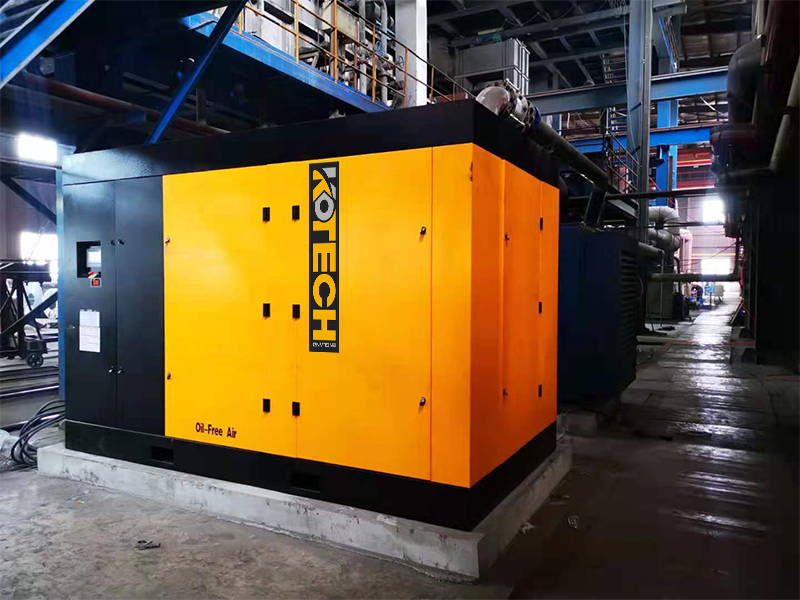
8.1. Oil-Free Air Compressors in the Medical, Food & Beverage, and Electronics & Semiconductor Industries:
Pharmaceutical Industry: Compressed air is used in various processes in the pharmaceutical industry, including filling machines for liquid preparations, granulators, mixers, filling machines, packaging machines, printing machines, extraction tanks, laboratory and pilot equipment, powder material transportation, drying, material blowing, pneumatic instruments, and automatic control systems. Compressed air must be clean and purified to meet production standards since it comes into direct contact with pharmaceuticals. Specific applications include:
- Capsule and Tablet Production: From mixing, hardening, granulating, drying, pressing, coating, to packaging, compressed air is used at every step. Compressed air comes into direct contact with pharmaceuticals, and any contamination with oil, water, or other impurities can compromise product quality. Even oil-free compressors must be equipped with post-treatment equipment to ensure purity.
- Fermentation: Fermentation equipment relies on sterile air. Contaminated air can lead to product contamination.
- Instrument Air: All tools used in the manufacturing process are powered by compressed air. The gas in these tools must be pure as it comes into contact with the product.
- Filling and Packaging: Various packaging methods, including blister packs, bottles, lightweight plastic containers, and cartons, require clean and moisture-free compressed air.
- Drying: Removing solvents or water from products requires dry compressed air.
Example: KOTCH oil-free dry screw compressor (250kW) is used in a pharmaceutical factory for the following processes:
- Capsule Production: Ensures all production stages use clean, oil-free air.
- Fermentation: Supplies sterile air.
- Instrument Air: Provides pure air for manufacturing tools.
- Filling and Packaging: Removes moisture from packaging.
- Drying: Dries products by removing solvents and water.
8.2. Oil-Injected Air Compressors in Manufacturing, Construction, and Other Industries:
Construction Industry: Air compressors are used to power pneumatic tools commonly found on construction sites, such as drills, impact wrenches, trowels, and paint sprayers.
Chemical Industry: Air compressors provide a stable supply of compressed air for mixing gases, transporting fluids, and stirring liquids in various chemical production processes.
Manufacturing Industry: In automotive manufacturing, air compressors are used to compress air to high pressure for driving paint sprayers and thread cutters. In metal processing, compressors power grinding tools, stamping machines, and pneumatic spraying equipment.
Example: KOTECH diesel mobile oil-injected air compressor (185 cfm) is used to power pneumatic jackhammers for road construction and maintenance:
9. Conclusion
In summary, both oil-injected and oil-free air compressors have their respective advantages and disadvantages. When choosing an air compressor, it is essential to consider the specific industrial application requirements. For high-efficiency industrial applications, an oil-injected air compressor may be the better choice. For environmentally friendly and safe applications, an oil-free air compressor is preferable. Additionally, budget constraints play a role, as oil-injected compressors are generally more affordable.
Given that air compressors operate under high temperatures, high pressures, and high speeds, proper maintenance is crucial. It is important to select compressors from reputable manufacturers to ensure reliable after-sales service. KOTECH offers both oil-injected and oil-free air compressors, featuring GHH main units from Ingersoll Rand, renowned Siemens motors, Siemens inverters, and Siemens electrical controls, ensuring stable quality and long operational life. The company has a professional after-sales team that guarantees a response to any after-sales issues within two hours. Feel free to consult us for more information.
